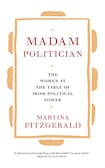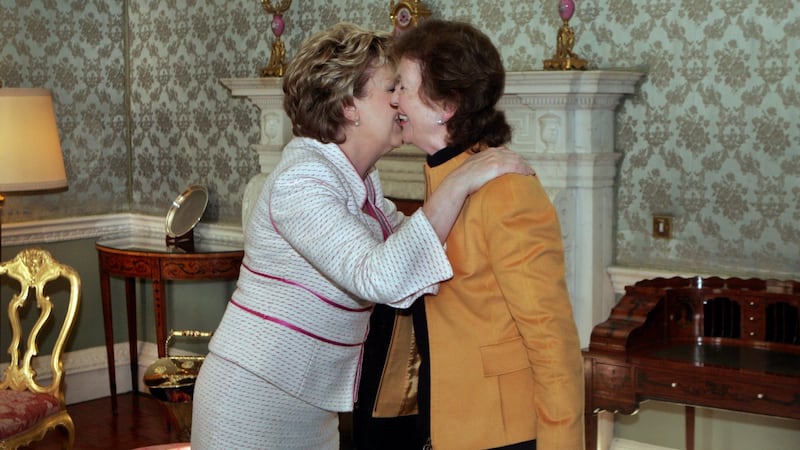
The title of this book is wrong. The context of this book is regrettably disappointing. By accident or design, it does a disservice to the 19 women who have served in Cabinet in the history of this State, a period of almost a century. They are Ministers in Government like their male counterparts, not Madam politicians. Being elected, not to mind being promoted, is the great leveler in politics.
Martina Fitzgerald, RTE's political correspondent, has written this book from a sort of a #MeToo perspective. She has brought the women TDs along with her. It probably makes it more readable than an historical political book about women ministers. There is a whole chapter on Sexism - hashtag politicianstoo. There is another on Media and Appearance - Looking Great but What Did She Say? And another again on Family and Friends - Constant Guilt. That is the kind of book it is. Whether that is her agenda or the agenda that the 17 surviving Ministers (and two historic women presidents) knowingly acquiesced to in individual interviews is not clear. But, whatever the case, the ministers do themselves no service.
“The women at the table of Irish political power,” the subtitle on the cover of the book, also demonstrates a sort of inferior attitude. It wouldn’t be said of the men who became taoisigh, tánaiste and ministers. The women ministers were extremely high achievers in the politics of their time. They were trailblazers and, for the most part, they left a substantial legislative legacy. They weren’t token women and, with the exception of one candidate, Josepha Madigan, an able quota candidate in the last general election, they fought the same fight to get into politics as men.
Among them, four reached the high office of Tánaiste: the first being Mary Harney, the longest-serving woman minister in history of the State; Joan Burton, leader of the Labour Party; Mary Coughlan, deputy leader of Fianna Fáil and Frances Fitzgerald in Fine Gael. We haven’t had our Margaret Thatcher nor our Theresa May yet but we have had two very successful Mary presidents.
For all of that, there are interesting insights into how hard it was for women to break through the party system to get a nomination to stand for election, never mind a ministry. The attitudes are worth recording. Most of the first women TDs elected to the Dáil were the widows, daughters or relatives of deceased male TD members. Between 1922 and 1977, just 24 women were elected to the Dáil and, according to the book, 80 per cent were related to a former male TD. It is an interesting fact that after the 2011 general election, for the first time in the history of the State,”no female TDs were related to a former TD”.

Countess Constance Markievicz was the first Irish woman to hold a Cabinet position when she became minister for labour in 1919, a century ago. She fought in the Easter Rising. She was one of the founding members of Fianna Fáil in 1926. She died in 1927.
It took a full 60 years before Maire Geoghegan-Quinn was appointed as the second woman minister in 1979. She tells an interesting story about it. Charles Haughey had just become Taoiseach in the most divisive political leadership campaign in history. She was called in and thought she was going to be “chopped” as a junior minister.
“Well Maire, I think you and I are going to make history,” he said. She looked at him and asked him what did he mean. He said: “I’m appointing you Minister for the Gaeltacht”. Her response was “Do you think, I’m able for it? To this day, she says, “I regret that I said that. I really do”. She was, in my opinion, the only woman TD who could have become Taoiseach.
Mary O’Rourke tells a different kind of story. She was minister for both education and health between 1987-1992. She says they were perceived as “kind of womanly” departments. She later became minister for enterprise (1997-2002). From the outset of her career in national politics in the early 1980s, she was very conscious of not being pigeonholed on gender grounds. As a result, she twice turned down offers from Mr Haughey to be spokesperson on women’s affairs.
Taoiseach Garret FitzGerald, appointed Gemma Hussey as the first minister for mducation in the Fine Gael/Labour Coalition in December, 1982. It provoked what she described as a “culture shock” among several male ministerial colleagues. The cost of reducing food subsidies was under discussion and the late Jim Mitchell was calculating the impact on the price of rashers and sausages. “Gemma, come here, what is the price of a pound of rashers?”
Dr FitzGerald interjected: “How would that woman know any more about the price of a pound of rashers than you would? She is out working all of the hours that God gives, like you are.”
Mary Harney recounts an amazing story about her time serving as junior minister with responsibility for environmental protection from 1989 to 1992. It was the first Fianna Fáil/Progressive Democrats Coalition. Relations with her senior minister, Padraig Flynn, were not good. She says that she had to come in through a side door, not the front entrance, in the Custom House where the main business of the department took place.
These are interesting personal stories showing the human side of politics and the male environment inside Leinster House over most of the last 40 years. There was, for example, no woman’s toilet near the Cabinet Room, the Dáil chamber nor the members’ bar.
Yet, there is something regrettable and demeaning about the way the book portrays the 17 surviving women ministers and diminishes their considerable, sometimes revolutionary, political contribution to Irish life. Nora Owen set up the Criminal Assets Bureau, a model that has been followed in other countries. Niamh Bhreathnach introduced free third-level education. Mary Harney reformed cancer treatment services. Maire Geoghegan-Quinn decriminalised homosexuality.
These are just a few examples and Madam Politician does not adequately acknowledge them.
Geraldine Kennedy is a former editor of The Irish Times, political correspondent and TD










